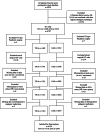Propofol total intravenous anaesthesia versus inhalational anaesthesia for acute postoperative pain in patients with morphine patient-controlled analgesia: a large-scale retrospective study with covariate adjustment
- PMID: 35538421
- PMCID: PMC9088064
- DOI: 10.1186/s12871-022-01683-9
Propofol total intravenous anaesthesia versus inhalational anaesthesia for acute postoperative pain in patients with morphine patient-controlled analgesia: a large-scale retrospective study with covariate adjustment
Abstract
Background: To compare the postoperative analgesic effect of propofol total intravenous anaesthesia (TIVA) versus inhalational anaesthesia (GAS) in patients using morphine patient-controlled analgesia (PCA).
Methods: A retrospective cohort study was performed in a single tertiary university hospital. Adult patients who used PCA morphine after general anaesthesia across 15 types of surgeries were included. Patients who received propofol TIVA were compared to those who had inhalational anaesthesia. Primary outcomes assessed were postoperative numerical rating scale (NRS) pain scores and postoperative opioid consumption.
Results: Data from 4202 patients were analysed. The overall adjusted NRS pain scores were significantly lower in patients who received propofol TIVA at rest (GEE: β estimate of the mean on a 0 to 10 scale = -0.56, 95% CI = (-0.74 to -0.38), p < 0.001; GAS as reference group) and with movement (β estimate = -0.89, 95% CI = (-1.1 to -0.69), p < 0.001) from postoperative days (POD) 1-3. Propofol TIVA was associated with lower overall adjusted postoperative morphine consumption (β estimate = -3.45, 95% CI = (-4.46 to -2.44), p < 0.001). Patients with propofol TIVA had lower adjusted NRS pain scores with movement for hepatobiliary/pancreatic (p < 0.001), upper gastrointestinal (p < 0.001) and urological surgeries (p = 0.005); and less adjusted postoperative morphine consumption for hepatobiliary/pancreatic (p < 0.001), upper gastrointestinal (p = 0.006) and urological surgeries (p = 0.002). There were no differences for other types of surgeries.
Conclusion: Propofol TIVA was associated with statistically significant, but small reduction in pain scores and opioid consumption in patients using PCA morphine. Subgroup analysis suggests clinically meaningful analgesia possibly for hepatobiliary/pancreatic and upper gastrointestinal surgeries.
Trial registration: This study is registered at ClinicalTrials.gov ( NCT03875872 ).
Keywords: General anaesthesia; Opioid consumption; Postoperative analgesia; Postoperative pain; Propofol; Total intravenous anaesthesia.
© 2022. The Author(s).
Conflict of interest statement
None declared.
Figures
Similar articles
-
The analgesic effect of total intravenous anaesthesia with propofol versus inhalational anaesthesia for acute postoperative pain after hepatectomy: a randomized controlled trial.BMC Anesthesiol. 2023 Apr 3;23(1):112. doi: 10.1186/s12871-023-02063-7. BMC Anesthesiol. 2023. PMID: 37013472 Free PMC article. Clinical Trial.
-
The effect of total intravenous anaesthesia with propofol on postoperative pain after third molar surgery: A double-blind randomized controlled trial.Eur J Pain. 2019 May;23(5):884-893. doi: 10.1002/ejp.1354. Epub 2019 Feb 1. Eur J Pain. 2019. PMID: 30592344 Clinical Trial.
-
The analgesic effects of intraoperative total intravenous anesthesia (TIVA) with propofol versus sevoflurane after colorectal surgery.Medicine (Baltimore). 2018 Aug;97(31):e11615. doi: 10.1097/MD.0000000000011615. Medicine (Baltimore). 2018. PMID: 30075537 Free PMC article.
-
Total Intravenous Anesthesia (TIVA) With Propofol for Acute Postoperative Pain: A Scoping Review of Randomized Controlled Trials.Asian J Anesthesiol. 2020 Sep 1;58(3):79-93. doi: 10.6859/aja.202009_58(3).0001. Epub 2020 Nov 3. Asian J Anesthesiol. 2020. PMID: 33176410
-
[Total intravenous anesthesia. On the way to standard practice in pediatrics].Anaesthesist. 2003 Sep;52(9):763-77. doi: 10.1007/s00101-003-0560-5. Anaesthesist. 2003. PMID: 14504802 Review. German.
Cited by
-
The incidence, impact, and risk factors for moderate to severe persistent pain after breast cancer surgery: a prospective cohort study.Pain Med. 2023 Sep 1;24(9):1023-1034. doi: 10.1093/pm/pnad065. Pain Med. 2023. PMID: 37184910 Free PMC article.
-
The effect of isoflurane versus propofol-based total intravenous anesthesia on hemodynamic stability, intraoperative blood loss, surgical field quality, recovery characteristics, and complications in patients undergoing posterior lumbar fusion surgery: a randomized clinical trial.BMC Anesthesiol. 2025 Jul 30;25(1):373. doi: 10.1186/s12871-025-03254-0. BMC Anesthesiol. 2025. PMID: 40739485 Free PMC article. Clinical Trial.
-
Total intravenous anesthesia for liver resections: anesthetic implications and safety.Korean J Anesthesiol. 2022 Oct;75(5):363-370. doi: 10.4097/kja.22517. Epub 2022 Sep 28. Korean J Anesthesiol. 2022. PMID: 36167475 Free PMC article.
References
-
- Gerbershagen HJ, et al. Pain intensity on the first day after surgery: a prospective cohort study comparing 179 surgical procedures. Anesthesiology. 2013;118(4):934–944. - PubMed
-
- Kehlet H, Jensen TS, Woolf CJ. Persistent postsurgical pain: risk factors and prevention. Lancet. 2006;367(9522):1618–1625. - PubMed
-
- Beattie WS, Badner NH, Choi PT. Meta-analysis demonstrates statistically significant reduction in postoperative myocardial infarction with the use of thoracic epidural analgesia. Anesth Analg. 2003;97(3):919–920. - PubMed
-
- Richebe P, Brulotte V. Anaesthesia maintenance with propofol versus sevoflurane to reduce postoperative pain: Still too early for recommendations? Eur J Pain. 2019;23(5):847–848. - PubMed
Publication types
MeSH terms
Substances
Associated data
LinkOut - more resources
Full Text Sources
Medical


